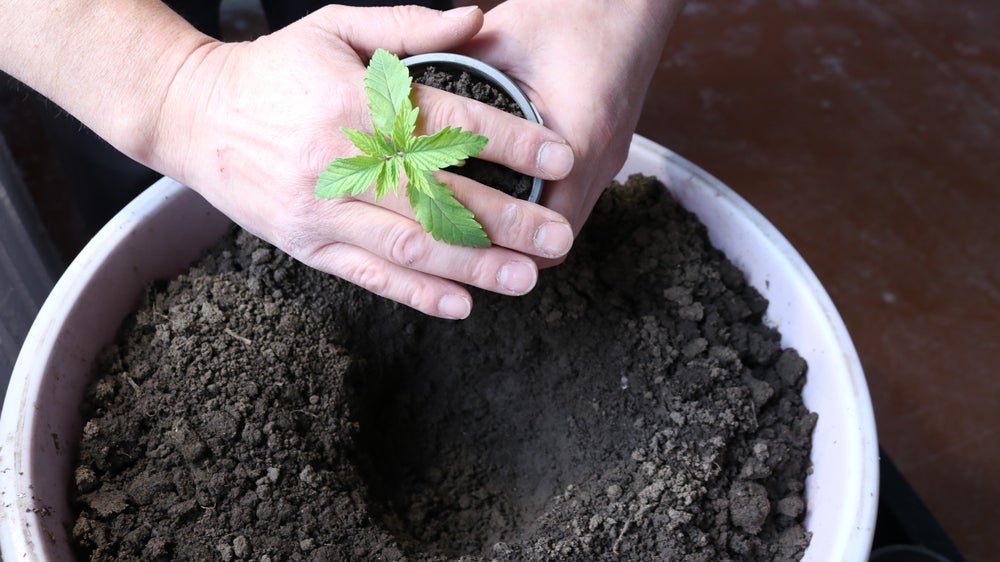Transplanting cannabis clones into larger containers is a pivotal moment in their growth journey, marking the transition from their initial rooting phase to a more expansive environment that encourages robust development. This process requires precision, care, and an understanding of the plant’s needs. In this comprehensive guide, we’ll explore the reasons for transplanting, the optimal timing, step-by-step instructions, and tips for ensuring a successful transition.
Understanding the Need for Transplanting
Transplanting cannabis clones into larger containers serves multiple purposes essential for their health and development. As clones outgrow their initial rooting containers, they exhaust the available nutrients and space. Transplanting provides the following benefits:
Enhanced Root Development:
Larger containers offer more space for root expansion, allowing the plants to develop a robust and healthy root system. This, in turn, supports overall plant growth and nutrient absorption.
Prevention of Root Bound Issues:
Root binding occurs when the roots of the plant outgrow the available space in their current container. This can lead to stunted growth, nutrient deficiencies, and other issues. Transplanting into larger containers prevents root binding, ensuring the plant can thrive.
Sustained Nutrient Availability:
As cannabis clones grow, they deplete the nutrients present in their initial rooting medium. Transplanting into fresh, nutrient-rich soil or growing medium provides the plants with access to a new supply of essential nutrients.
Improved Water Retention:
Larger containers retain water more effectively, reducing the frequency of watering and providing a more stable environment for the plants. This helps prevent stress and dehydration during critical growth phases.
Optimal Timing for Transplanting
Timing is crucial when it comes to transplanting cannabis clones into larger containers. The decision to transplant should be based on the following factors:
Root Development:
Wait until the clones have developed a healthy root system. This is typically indicated by the appearance of roots at the drainage holes of the current container and a well-established network visible when gently removing the plant from its current medium.
Leaf and Stem Growth:
Look for signs of vigorous vegetative growth, including the development of multiple sets of leaves and a sturdy stem. Transplanting at this stage ensures that the plants can effectively utilize the new space for further development.
Environmental Conditions:
Choose a time when the environmental conditions are favorable. Avoid transplanting during extreme temperatures or under stressful conditions, as this can increase the risk of shock and hinder the plants’ ability to acclimate to their new containers.
Step-by-Step Guide to Transplanting Cannabis Clones
Prepare the New Containers:
Ensure that the larger containers are clean and have sufficient drainage holes. Fill them with a high-quality, well-draining growing medium. This could be a mix of soil, perlite, and coco coir to promote aeration and prevent waterlogging.
Water the Clones:
Before transplanting, water the clones in their current containers. Moist soil facilitates easier removal and minimizes stress on the plants. Allow the water to be absorbed for a few hours, ensuring the soil is adequately hydrated.
Gently Remove the Clones:
Carefully loosen the soil around the clones in their current containers. Hold the plant at its base, supporting the stem and leaves with your hand. Turn the container upside down and gently tap the bottom to release the plant and its root ball.
Inspect and Trim Roots (If Necessary):
Examine the root system for any signs of circling or compacted roots. If you observe such issues, gently tease apart the roots or trim them with clean, sharp scissors. This encourages outward growth and prevents the development of a tangled root mass.
Place the Clones in New Containers:
Create a hole in the center of the new containers large enough to accommodate the root ball of each clone. Settle the clone into the hole, ensuring that it sits at the same depth as it did in the previous container. Backfill with the growing medium, lightly pressing to secure the plant.
Watering and Settling:
After transplanting, water the clones thoroughly to settle the soil and eliminate air pockets. Ensure that water reaches the entire root ball. Allow excess water to drain, and observe the containers for any settling of the soil. Add more medium if necessary.
Monitor and Adjust:
Place the newly transplanted clones in a shaded or partially shaded area initially to reduce stress. Gradually reintroduce them to their usual light conditions over a day or two. Monitor the plants closely for the first few days, adjusting environmental conditions as needed.
Resume Regular Care Routine:
Once the clones have shown signs of recovery and adaptation, resume your regular care routine. This includes providing appropriate light, maintaining optimal temperature and humidity levels, and adjusting nutrient levels as necessary.
Tips for Successful Transplanting
Choose the Right Container Size:
Select containers that provide ample space for root development without being excessively large. A good rule of thumb is to move to a container that is 1-2 inches larger in diameter than the current one.
Use High-Quality Growing Medium:
Invest in a high-quality growing medium that provides the necessary nutrients and promotes aeration. Well-draining soil or a soilless mix with added perlite or coco coir works well.
Avoid Disturbing the Root Ball:
Handle the clones and their root balls with care to avoid unnecessary stress. Minimize disturbance to the root system during the transplanting process.
Maintain Consistent Environmental Conditions:
Aim to keep the environmental conditions consistent before, during, and after transplanting. Sudden changes in temperature, light, or humidity can increase stress and hinder recovery.
Consider Transplant Shock:
It’s normal for plants to experience some degree of transplant shock. Be patient and allow the clones time to recover. Avoid making additional changes to their environment immediately after transplanting.
Provide Adequate Support:
If the clones are tall or leggy, consider providing support in the form of stakes to prevent them from bending or breaking during the transplanting process.
For practical tips and advice on homegrown Cannabis, check out our posts on How Long Does It Take To Fully Grow A Cannabis Plant?, Advantages of Growing Cannabis Clones Vs Seeds, and How Much Cannabis Can I legally Carry In The Canada.












